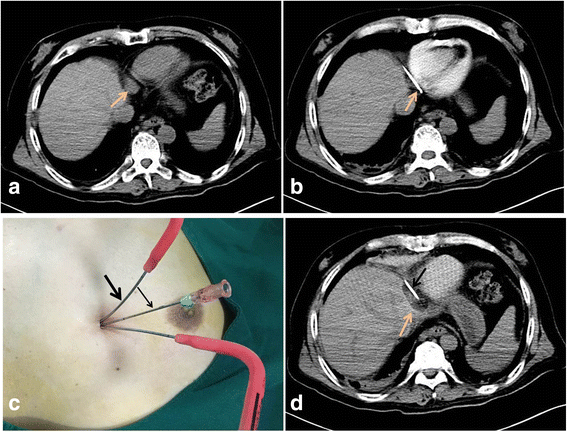Cryoablation of cardiophrenic angle lymph node metastases: a case report
- PMID: 28803547
- PMCID: PMC5554983
- DOI: 10.1186/s13256-017-1313-4
Cryoablation of cardiophrenic angle lymph node metastases: a case report
Abstract
Background: Cardiophrenic angle lymph node metastases are relatively rare. Surgical resection is the main treatment for cardiophrenic angle lymph node metastasis, but it is not always possible.
Case presentation: Here, we report our initial experience with cryoablation of a cardiophrenic angle lymph node metastasis from liver cancer. As the cardiophrenic angle lymph node metastasis was located close to the heart, about 200 mL of 0.9% saline was injected into the pericardium to separate the heart from the target area. The cardiophrenic angle lymph node metastasis was successfully ablated, without any complications.
Conclusions: Cryoablation may be a suitable alternative treatment for cardiophrenic angle lymph node metastasis.
Keywords: Cardiophrenic angle lymph node; Cryoablation; Lymphatic metastasis.
Figures




References
-
- Bang HJ, Littrup PJ, Currier BP, Goodrich DJ, Aoun HD, Klein LC, Kuo JC, Heilbrun LK, Gadgeel S, Goodman AC. Percutaneous cryoablation of metastatic lesions from non-small-cell lung carcinoma: initial survival, local control, and cost observations. J Vasc Interv Radiol. 2012;23(6):761–9. doi: 10.1016/j.jvir.2012.02.013. - DOI - PMC - PubMed
-
- Gage AA, Baust JG. Cryosurgery - a review of recent advances and current issues. Cryo Letters. 2002;23(2):69–78. - PubMed
Publication types
MeSH terms
LinkOut - more resources
Full Text Sources
Other Literature Sources
Medical
Research Materials

